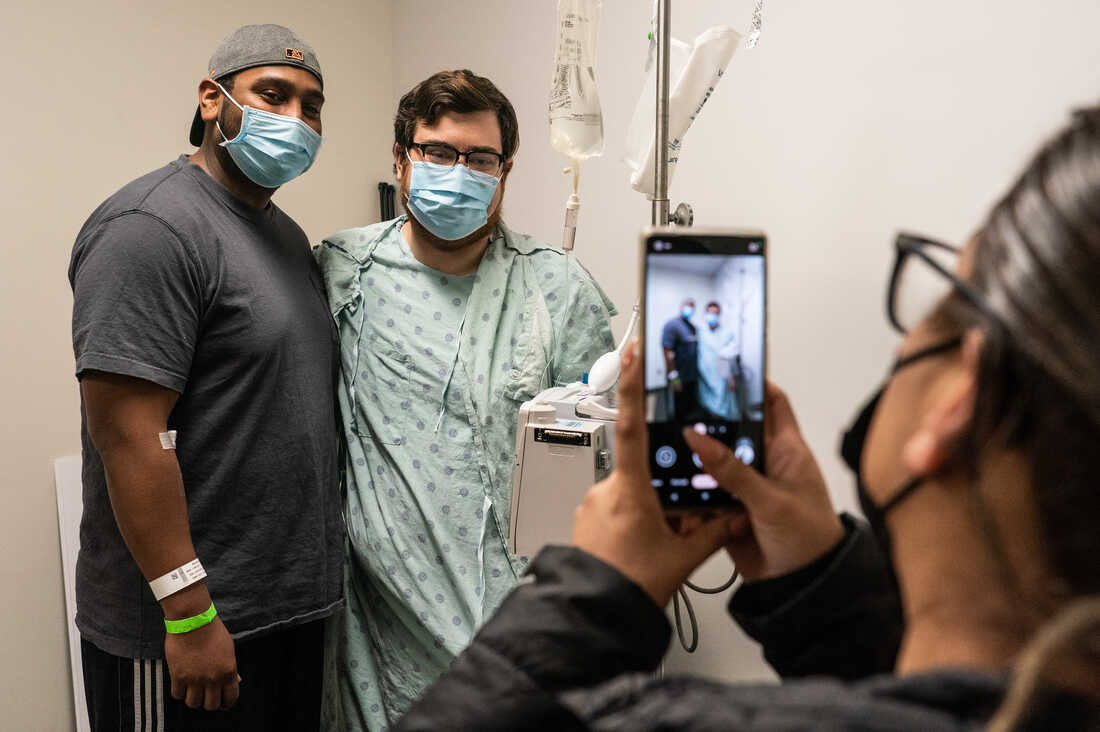
Amazing
Ten Strangers Create a Kidney Swap Chain
While it is still risky, living kidney donation can be a good alternative to deceased kidney donation. About one-third of kidney transplants in the United States are living transplants. One of the biggest advantages is that one living kidney can replace two failing kidneys. A living kidney donation also means those in need of kidneys have a shorter stay on the waiting list. Live donations are scheduled in advance where emergency surgery is needed if the donated kidney is from a deceased donor.
Live kidney donators are evaluated ahead of time and are typically genetically related to the recipient. All of these factors combine to provide not only less time on a waiting list for the recipient, as well as better short and long-term survival statistics.
All of this information was taken into consideration when the ten-person kidney swap chain was planned at Houston Methodist Hospital in the spring of 2021. The chain started with the laparoscopic removal of Michael Wingard’s left kidney. The surgeon, Dr. Link, made a two-inch incision through which he removed the kidney. Heather O’Neill Smarrella will receive the kidney because the friend he was originally trying to donate to was not a match. The chain continues when Heather’s twin sister Staci O’Neill donates her kidney to Javier Ramirez Ochoa. Ochoa’s son-in-law, Tomas Martinez, is donating his kidney to Chris McLellan. His father, David, continues the line when he donates to Barbara Morton. Morton’s daughter, Lisa Jolivet, gave her kidney to Kaelyn Connelly. Connelly may be the last recipient in the ten-person chain, but she is the person Wingard, the first person in the chain, was originally trying to donate to.
The process was long and tedious and occurred over a four-day period. This ten-person chain is unusual because there are typically only six people involved. The surgeries were postponed three times because there are so many factors involved and each transplant has to line up perfectly to the next one in the line. However, with roughly 90,000 people on the Oregon Procurement and Transplantation Network list who are waiting, the three postponements are considered worth it by the participants and their friends and families. Many of the 90,000 people on the Oregon transplant list will wait years for their kidneys and some will not live long enough to receive a kidney.
A last added benefit of these living organ transplants is that the kidneys are expected to work for twelve to twenty years while a kidney donated by a dead donor is expected to last eight to twelve years. Though the ten-person kidney swap is not a typical one, in this case, it saved many lives and also gave the recipients a quality of life they would not have had otherwise.
Amazing
Rescue Dog Leads Police to Injured Owner, Hailed as a “True Hero”

A loyal rescue dog named Gita is being celebrated for saving her elderly owner’s life after leading a police officer to a remote cabin where the man lay injured.
In rural Stevens County, Washington, Gita, a 13-year-old rescue dog, refused to leave her owner’s side after he suffered a serious fall. Police were unaware of the situation until Deputy Wright, on a routine patrol two weeks ago, spotted Gita sitting in the middle of the road with no homes in sight.
The Stevens County Sheriff’s Office shared the remarkable story on their Facebook page, emphasizing the critical role Gita played in the rescue. After attempting to coax the dog into his vehicle with no success, Deputy Wright sensed that something was wrong. He searched the nearby area within a mile radius but found nothing and trusted his instincts to keep following Gita.
“Gita is a 13-year-old rescue and best friend to the man in trouble,” the sheriff’s office stated. “Had it not been for her, the outcome could have been much worse. We owe this rescue to Gita’s loyalty and quick thinking.”
When the dog led the officer down a lesser-known roadway, Wright discovered a small summer cabin. It was there, not far from the cabin, that he found the 84-year-old man on the ground, injured and calling for help. The man had fallen, hurt his leg, and required his regular medication due to other health issues.
While the sheriff’s office hasn’t released further details about the man’s condition, they praised both the deputy and Gita for their actions, concluding their post with: “Thank you, Deputy Wright, for your dedication, and thank you Gita, for being a good girl and a true hero.”
A family member of the elderly man shared her gratitude online, noting that he is her 91-year-old mother’s cousin. “We are so thankful to Deputy Wright and the Stevens County Sheriff’s Office. And of course, Gita, for being there when it mattered most.”
The story quickly gained attention, with many applauding both the officer’s instincts and Gita’s heroic behavior.
Amazing
Utah Woman Donates Kidney to Man She Met on a Hike

In an inspiring turn of events, a Utah County woman donated her kidney to a man she had only recently met on a hike.
Krissy Miller crossed paths with Shiller Joseph while hiking on Y Mountain, near Brigham Young University, in September 2023. During their chance meeting, Miller, a 49-year-old mother of four, learned that Joseph was in desperate need of a kidney. Without hesitation, she offered one of hers. Following medical tests, it was confirmed that they were a compatible match.
The story took an even more heartwarming turn when, after their initial encounter, Miller presented Joseph with what appeared to be a box of rolls. But inside the box was a sign that revealed her incredible gift — she would be his kidney donor.
On Monday, the pair reunited at Intermountain Health in Murray after a successful transplant surgery. Their emotional meeting came after months of preparation and surgery that gave Joseph, 45, a new chance at life.
Joseph, who has lupus, had been on the kidney transplant waiting list for some time. The average wait time for a kidney transplant in the U.S. is three to five years, with more than 90,000 people currently waiting for a life-saving organ. The National Kidney Foundation estimates that around 20 people die each day while waiting for a transplant, underscoring the critical need for organ donors.
Miller’s decision to donate her kidney without hesitation showcases the profound impact one person can make in the face of overwhelming need. This act of kindness not only saved Joseph’s life but also shines a spotlight on the importance of organ donation.
Amazing
A Young Hero for Hens

Harriet, a 12-year-old from Chart Sutton, Kent, is making a difference in the lives of farm hens. Every Saturday morning, she volunteers with Fresh Start For Hens, a local charity dedicated to finding new homes for commercial egg-laying hens.
These hens, typically 72 weeks old, are often destined for slaughter when their egg production declines. However, Fresh Start For Hens buys them from farms and rehomes them as pets.
At collection points like the one in Aylesford, Harriet helps transfer over 100 hens from farms to their new owners. The charity ensures potential adopters provide suitable living conditions for the hens, requiring photos of coops and runs, along with a minimum donation of £2.75 per bird.
Many of these hens arrive in poor condition, sometimes even bald from stress-induced feather pecking. Harriet explains, “They get quite bored, so they peck each other and rip out their feathers.” Remarkably, after a few weeks in their new homes, most hens regain their feathers.
Harriet’s dedication earned her the BBC Young Reporter award. She hopes her story will inspire more farmers to choose rehoming over slaughter for their hens. As Harriet puts it, “It makes me feel proud that I can do something for these chickens, save their lives and give them to these happy families.”
The charity operates entirely on volunteer efforts. Petrina Thomas, who leads collection mornings, believes they’re all motivated by a simple principle: “the love of hens.”
Amazing
Social Media Miracle: Stranger’s Selfless Act Saves Baby’s Life

Amazing human kindness helped give a six-month-old girl named Helin Dinlera second chance at life. It’s all thanks to the generosity of a stranger who responded to an urgent online plea. Helin, diagnosed with a rare and life-threatening liver condition called Biliary Atresia, faced a grim prognosis without a liver transplant.
When no family members were found to be suitable donors, Helin’s mother, Anna Shushura, turned to social media in a desperate attempt to find help. Her emotional appeal caught the attention of Letty Fenlon, a 27-year-old show jumper from Yorkshire, who felt compelled to act.
Letty, already registered as an organ donor, underwent extensive testing and was confirmed as a match for Helin. Despite the risks associated with major surgery, Letty’s determination to help prevailed. In May, she underwent a six-hour procedure to donate a portion of her liver to the infant.
The transplant was successful, and now, at nine months old, Helin is thriving. While she still requires regular medical check-ups, her progress has been remarkable. Helin’s family expresses immense gratitude towards Letty, whose selfless act has given their daughter a chance at a normal life.
Amazing
Trust and Perseverance: The Remarkable Rescue of Lessie from the Boundary Waters

A heartwarming tale of survival and rescue has emerged from Minnesota’s Boundary Waters, where a German Shepherd named Lessie was found after being lost for 55 days. This story highlights the importance of trust-building and community effort in reuniting lost pets with their families.
Lessie’s ordeal began when she escaped following a car accident on the Gunflint Trail near Grand Marais in late June. The Retrievers, a non-profit organization dedicated to finding missing dogs, immediately mobilized to assist in the search.
After a month of uncertainty, hope was rekindled when Lessie was spotted near Ham Lake, miles from the accident site. A Minneapolis-based volunteer, familiar with the area, stepped up to help. Armed with guidance from The Retrievers and his previous experience, he set up camp to search for Lessie.
The volunteer’s patient approach proved crucial. Using food and a trail camera, he gradually gained Lessie’s trust over several days. His persistence paid off when he finally managed to leash Lessie and lead her to safety, facilitating an emotional reunion with her owners.
Jennifer Cadigan of The Retrievers emphasized the intelligence and resilience of dogs, noting that Lessie likely survived on discarded fish remains from nearby campsites. This remarkable story serves as an inspiring reminder to never lose hope when searching for a lost pet.
The successful rescue of Lessie after nearly two months in the wilderness underscores the effectiveness of combining community involvement, expert guidance, and unwavering determination in resolving missing pet cases.
-

 OMG6 years ago
OMG6 years agoA Couple Gave Birth to the Most Beautiful Twins Ever
-

 OMG7 years ago
OMG7 years ago20 Rare Historical Photos
-

 OMG6 years ago
OMG6 years agoHilarious Airport Photos
-

 Cute6 years ago
Cute6 years agoMom Refuses to Let Daughter Eat Sugar and Years Later This is What She Grows Into
-

 OMG6 years ago
OMG6 years agoTop Secret Air Force One Facts That You Never Knew
-
OMG6 years ago
The Funniest Yearbook Photos Of All Time
-

 OMG6 years ago
OMG6 years agoRetired Mathematician Restores Log Cabin
-

 OMG5 years ago
OMG5 years agoWhat Happened When This ‘Duck Dynasty’ Legend Chopped Off His Beard?